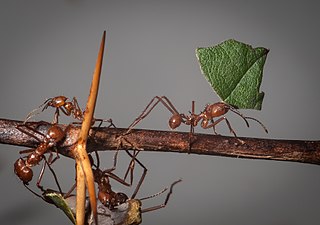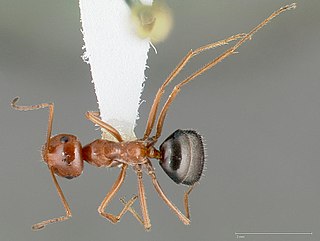
Leafcutter ants are fungus-growing ants that share the behaviour of cutting leaves which they carry back to their nests to farm fungus. Next to humans, leafcutter ants form some of the largest and most complex animal societies on Earth. In a few years, the central mound of their underground nests can grow to more than 30 m (98 ft) across, with smaller radiating mounds extending out to a radius of 80 m (260 ft), taking up 30 to 600 m2 and converted into 3.55 m individuals.

Dorymyrmex insanus is a species of pyramid ant, one of several species known as crazy ants, for their "frenetic" movement and swarming behavior. It is found in hot, dry habitats in the southern parts of the United States, much of Central America, and tropical South America. Dorymyrmex insanus is listed as Vulnerable by the International Union for Conservation of Nature (IUCN).

Pogonomyrmex anergismus is a species of workerless inquiline ant in the subfamily Myrmicinae native to Arizona, New Mexico, and Texas that parasitizes Pogonomyrmex rugosus and Pogonomyrmex barbatus nests.

Pogonomyrmex colei is a species of workerless inquiline ant in the subfamily Myrmicinae native to California, Nevada, and Arizona that parasitizes Pogonomyrmex rugosus nests.

Tetramorium caespitum, also known as the red pavement ant, is a species of Myrmicine ant native to Europe, Morocco, and western Asia, but now found on many other continents as a tramp species.
Camponotus silvestrii is a species of carpenter ant in the genus Camponotus native to northern Brazil.

Pogonomyrmex rugosus, the desert harvester ant or rough harvester ant, is a species of harvester ant in the subfamily Myrmicinae which is endemic to the southwestern United States, specifically New Mexico and southern Colorado.

Tyrannomyrmex rex is a species of ant in the subfamily Myrmicinae native to Malaysia and Singapore.

Myrmecocystus placodops is a species of honeypot ant native to the southwestern United States and northern Mexico.

Myrmecocystus kennedyi is a species of honeypot ant in the subgenus Endiodioctes native to the western United States and western Mexico.

Hypoponera punctatissima, or Roger's ant, is a species of Ponerine ant native to Africa but now found worldwide as a tramp species.

Pogonomyrmex desertorum, the large seed harvesting ant, is a species of harvester ant native to Mexico, the southwestern United States, and possibly Florida and Colorado.

Camponotus clarithorax is a species of carpenter ant of the subgenus Camponotus native to California, Oregon, the Baja California Peninsula, and possibly the eastern United States.

Myrmecocystus yuma is a species of honeypot ant native to the southwestern United States and a small part of Northern Mexico. This species, like most in the genus Myrmecocystus, create worker repletes.

Camponotus sericeiventris, the shimmering golden sugar ant, is a species of carpenter ant native to large parts of Central and South America. It is the only species in the subgenus Myrmepomis.

Camponotus fallax is a species of carpenter ant native to Europe, Asia, northern Africa, and possibly North America and South Korea.

Syllophopsis is a genus of Myrmicine ants found across the Southern Hemisphere and the tropics except South America.

Camponotus pudorosus is a species of carpenter ant native to Arizona, New Mexico, Colorado, Mexico, and Guatemala. Originally described in 1925 by Carlo Emery and synonymized by W. W. Kempf in 1972, the species was revived in 2006 from the Camponotus festinatus complex by Roy Snelling.

Camponotus inaequalis is a species of carpenter ant native to Florida, the Bahamas, and Cuba.

Camponotus conspicuus is a species of carpenter ant native to Mexico, Central America, the Caribbean, Ecuador, and Colombia.



















